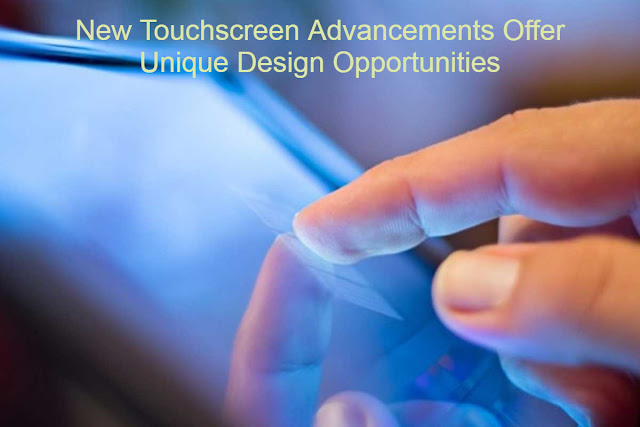New Touchscreen Advancements Offer Unique Design Opportunities
Touching New Heights: New Touchscreen Advancements Offer Unique Design Opportunities The rapid progression of touchscreen innovation over the past 20 years has brought the technology from niche application to an integral element of our everyday lives. We now live in a world where we expect nearly every industrial monitor to have touch interactivity. – young children today instinctually touch screens to use them and are surprised if they don’t react. From smartphones to self-service supermarket booths to ticket machines to museum information screens, touchscreens are now indispensable in our lives.
Although touchscreens are becoming more common every day, they still have a long way to go in terms of their implementation. Many designers are still unfamiliar with the details of touchscreen technology and select generic touchscreen designs in an attempt to remain “safe” – ultimately resulting in a product which is sub-par or does not meet its full potential.
Touchscreen innovation:
In response to this poor implementation, unique, bespoke-built touchscreen solutions are on the rise; as these solutions become more commonplace, their reliability improves whilst the cost of prototyping and manufacturing becomes far more manageable. Many companies are now realizing the advantages of choosing a solution which has been precisely tailored to the needs of the application, understanding the benefits it offers in terms of design appearance and improved user experience.
The market for these custom-built touchscreens is growing rapidly, as companies seek to provide functional, bespoke-built prototypes without the high engineering costs which could make the product impractical for mass sale. These projects have demanding needs, with the manufacturer needing to understand the unique requirements of the project at hand and design and implement a solution which is optimal for user experience in the desired environment.
In understanding what goes into making a touchscreen solution which can truly excel in its function, Ian Crosby of Zytronic, a tailor-built touchscreen manufacturer, shares his expertise. Ian gives his thoughts on what it takes to plan a touch interface which can truly be intuitive and functional in its use.
Getting started – what’s the project’s purpose?
The first consideration in any touchscreen project is to decide exactly what the purpose of your touchscreen will be – what need is it fulfilling? What size will the display need to be? Will it be used by one person at a time, or will it be used for collaborative purposes and need to respond to multiple inputs simultaneously?
These considerations need to be considered at the first stages of planning – installing a multi touch overlay later in the project, or after installation, is not possible with many types of displays. As with any project, planning is the most important element – all elements of the design must be considered in tandem, focusing on providing an integrated solution to the need being addressed and then refining the result throughout the prototype stages.
Hygiene in a COVID-19 world:
As the pandemic continues, any shared surfaces such as touchscreens must be carefully implemented to avoid the spread of corona-virus. Luckily, there are measures available to make touchscreens safe for use.
The most important element here is making touchscreens easy-to-clean. Try to plan your touchscreen to be flush where possible, offering a flat surface with no raised areas or recesses which could make the screen more difficult to clean and therefore harbor harmful viruses. Having a flat touchscreen surface will allow for regular and efficient cleaning, minimizing the risk of transferring the virus via the screen.
Many touchscreen types are also compatible with input from gloved hands, reducing the need for direct contact with the screen. In many cases, it is also possible to install a hand sanitizer station next to the touchscreen, encouraging people to sanitize their hands before and after usage.
Situational awareness:
What kind of environment is your touchscreen going to be used in? If being placed outdoors, additional measures will need to be taken to nullify the threat of bad weather and vandalism. Usually, this will take the form of using thicker glass – but these considerations must be implemented from the outset of the design process, as adding thicker glass later might mean your touchscreen won’t respond properly to touch or won’t work at all.
Other needs may be industry-specific; for example, in hospitals or other medical centers, the screens may need to work with gloved hands. These situational requirements are vital considerations throughout the design and manufacturing process.
Making touchscreens accessible:
As touchscreen technology is becoming such a crucial part of our lives, we must also ensure that these products provide fair accessibility for all, including visually impaired and disabled users. Again, this is something which should be discussed early in the process of designing a touchscreen, rather than attempting to shoehorn a rushed solution in at a later stage.
Choosing the appropriate touchscreen technology here is important. Luckily, touchscreen manufacturers today have quick turnarounds when producing prototypes to product designers, creating bespoke designed working models within days or weeks rather than months. This gives designers the freedom they need to test and improve their product solution, showing stakeholders and managers their test results as they go. 3D renderings can only go so far – showing those invested in the project physical prototypes goes a long way towards gaining and maintaining support.
The right touchscreen manufacturer should be prepared to consult with your design team throughout every stage of your touchscreen development, advising and assisting in understanding the challenges present in the application. With the advances in capacitive touchscreen technology we are seeing today,there is now no need to limit yourself to generic or unsuitable touch panels – we are now entering an age where your design ideas have an unprecedented level of freedom and possibility.
Interested in bespoke touchscreen paneling for your project? Contact Zytronic today to discuss your needs and project challenges.


No comments